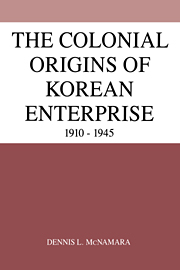4 - Japanese Investment
Published online by Cambridge University Press: 14 October 2009
Summary
If the colonial state helped structure the economy on the peninsula, so also did the massive business combines from the home islands. Japanese corporate investors left behind estimated assets of 3.5 billion dollars in 1945, representing 67 percent of total Japanese assets in Korea. Leading zaibatsu such as Mitsubishi, Mitsui, and Noguchi Jun's Nichitsu dominated the corporate share. Contrasting cultural with economic assimilation, the colonial scholar Yanihara Tadao concluded: “the invasion of the peninsula by Japanese capital is tantamount to an assimilation of Korea by the capitalistic structure of Japan.” Whatever the Japanese achieved culturally on the peninsula, they certainly succeeded in transferring the model of close relations between state and major private enterprise. The small number of Korean entrepreneurs can hardly be termed a third party in business on the peninsula. They rather went about their farming, commerce, and food processing in the shadow of a formidable alliance between colonial state and major zaibatsu.
The design of colonial state relations with the home island corporate giants permeated the colony's business climate in the formative years of large-scale local enterprise. There were parallels in the concentration of capital and ownership between the large Japanese firms and the native enterprises of the Mins, Pak and Kim.
- Type
- Chapter
- Information
- The Colonial Origins of Korean Enterprise1910–1945, pp. 51 - 65Publisher: Cambridge University PressPrint publication year: 1990



